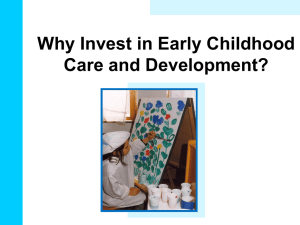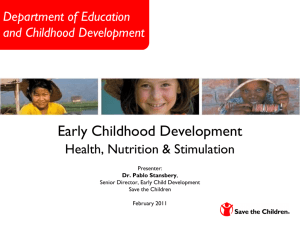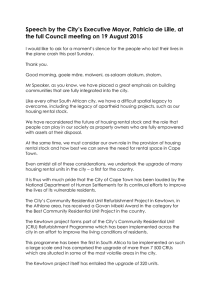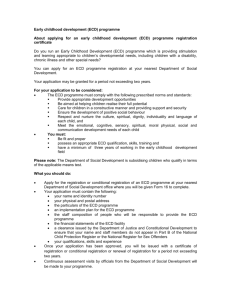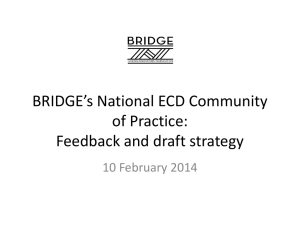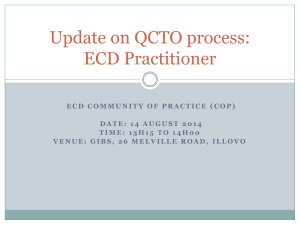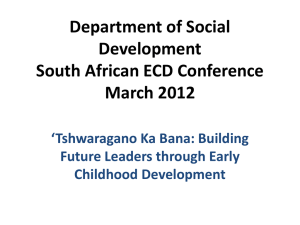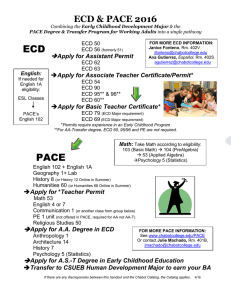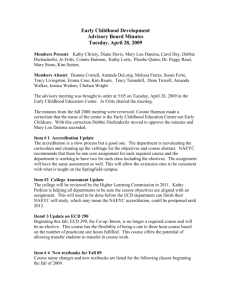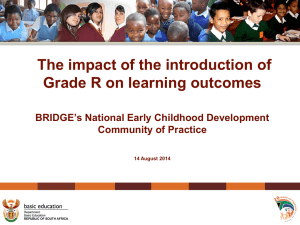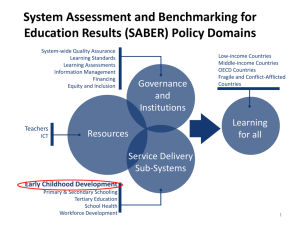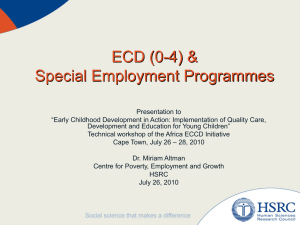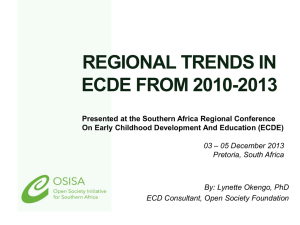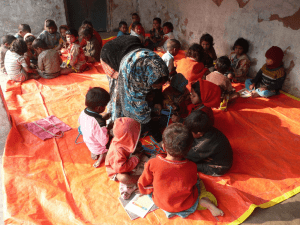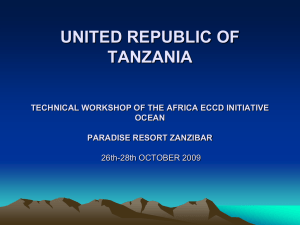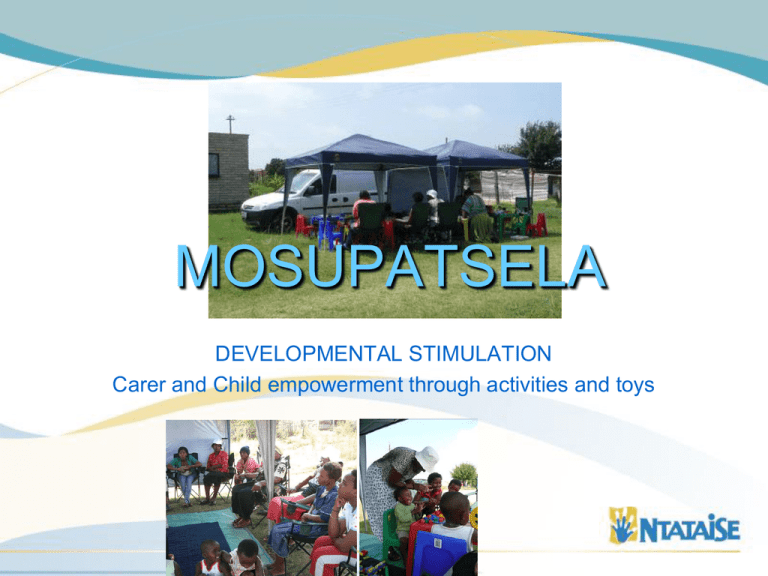
MOSUPATSELA
DEVELOPMENTAL STIMULATION
Carer and Child empowerment through activities and toys
What problem does the initiative seek to
address?
ACCESS
if done right, high-quality,
parent focused, ECD
programmes that began at birth
can make an extraordinary
difference in outcomes both for
the child and society.
QUALITY
What informed / inspired the initiative?
11 ECD Centres in Rammulotsi, Viljoenskroon, Free State
Province.
Vulnerable children
Children not ready for school
Reaches about 1186 children between the ages 0-5 years
Survey identified that children were not accessing ECD
centres / services – number unclear
Fee paying ECD services
Parents Perception
Farms – no transport
How was the initiative conceptualised?
Vulnerable children
To identify children who do not have access to ECD programmes and
establish parent-child ECD support groups in an attempt to reach them
Children not ready for school
Fee paying ECD services
Free of charge
Parents Perception
Farms – no transport
Mobile Unit to area
Parent component
Facilitate access to other services
Target school readiness
“Therapeutic”
2 hour programme
Formally trained Facilitator following designed programme with clear
guidelines
Orientation, preparation and monitoring by EXPERT
Trained Facilitator
following designed
programme with
clear guidelines and
ability to work with
parents
Who was involved and in what ways?
Facilitate access to other services
Dr Ingrid Herbst
Target school readiness
“Therapeutic”
2 hour programme
Trained Facilitator
following designed
programme with
clear guidelines and
ability to work with
parents
Formally trained Facilitator following designed programme with clear
guidelines (Concentration and memory; Reasoning abilities; Fine and gross
motor skills, Basic numeracy and literacy; Age appropriate social and
emotional development (particularly sharing, adherence to rules, Bonny -Ntataise
perseverance and emotional regulation).
Dr Ingrid Herbst
Orientation, preparation and monitoring by EXPERT
ILIFA Sobambisana
Research Team
3 year pilot – 2010 to 2012
2013 – 2 units operating in
Rammulotsi and Farm areas
Dikeledi Ntataise
3 year pilot measures
BASELINE
TESTING:
Measures of
school readiness
(Herbst tests)
TARGET
POPULATION:
CHILDREN NOT
ACCESSING
ECD SERVICES
IN
RAMMULOTSI
Identified through preschool
supervisors (known as Matrons)
Ntataise field workers and trainers.
Potential participants are invited to a
meeting at the centre or receive a
home visit to explain the programme.
They then decide whether or not to
enrol.
INTERVENTION
EVALUATION
SAMPLE
BASELINE
TESTING:
Knowledge of
ECD
MEASURE
IMPACT
Focus groups
Individual Interviews
H.O.M.E.
scales and the
Safety and
Hygiene
checklist
How has the initiative been implemented?
WHO?
COSTS
/RESOURCES?
TARGET
GROUP?
A vehicle transports the
practitioner, a gazebo, and
equipment, to a specific (and
different) site on each of four
days in the school term. Once
on site the gazebo is erected,
tables and chairs and
equipment are laid out, and
the programme for the
morning commences. A
healthy snack is served
Successes
Sobambisano Research results
Measure
Mosupatsela
Playgroups in Grade R
N = 36
Cognition: Grover Counter Scale
Language: Peabody Picture Vocabulary Test
(Se-Sotho version).
Numeracy 1: The Herbst Counting Test
Numeracy 2: The Herbst Number Concept
Test
Emotional Development 1: The South SACAS
School Readiness Sub-scale
Emotional Development 2: The SACAS
Resilience Sub-scale
No ECD
N = 26
39.24 (SD )
34.05 (SD )
48.66 (SD)*
45.99 (SD)
4.35 (SD)
4.19 (SD)
4.91 (SD)
3.78 (SD)
6.95 (SD)*
4.94 (SD)
12.56 (SD)
11.17 (SD)
Challenges
How many
sessions?
FACILITATORS
IMPLEMENTING
INTERVENTION
CHILDREN AND
PARENTS
ENRIOLLED IN
INTERVENTION
FINANCING OF
PROGRAMME
Quality of
sessions
Access of other
services
How many
sessions?
Cost per
child
Weather conditions
Other commitments by staff
Holiday periods – variations
in no of sessions offered
Preparation of sessions
Adherence to programme
guidelines
Follow up with departments
Formal meetings or
opportunities
Follow up visits to homes
Buddy system
Government funding
Other funding
Sharing of resources
Inspirations and possibilities
“Our children are really smart, my boy could not handle a pencil, now
he holds a pen like a teacher”.
They noted that their children’s behaviour had changed: they were able
to play with others and communicate appropriately with elders (an
important culturally required skill). Programme staff also commented on
improved pro-social skills as well as improvements in concentration and
perseverance (observing was an outcome of the programme or
development)
Parents felt that they had learned to take a serious interest in their
children’s education in particular but also their general well being.
They enjoyed and valued working on activities together.
However, there was a request for the programme to be offered more
than once a week and a parent mentioned that it was difficult to find
things at home to use as substitutes to the toys in the programme and
to practise the skills with the children.
Lessons learned
oSteps need to be taken to improve attendance - encouraging regular
child attendance is critical to realising positive outcomes and therefore
offering other options – e.g. toy library.
oNeed to monitor whether the programme is implemented at home and
encourage attendance through periodic home visits.
oRunning the programme outdoors affected attendance negatively
(cold, wet and windy weather) and therefore alternative venues or a
play bus option.
oNumbers reached is important when considering per child cost
(maintaining and scaling issue).
oOrganisational monitoring and evaluation is essential to maintaining
quality.
Inspirations and Possibilities
Initiative shared with Ntataise Network, Liberian group and
Department of Social Development (other provinces)
Recommendations
Expert input
Time to pilot or test and develop
Ongoing Monitoring and evaluation
Trained staff
Quality preparation and delivery of initiative according to tried and
tested guidelines
Integrate initiatives when possible
Link to essential services
Sharing of implementation challenges
COST
We need changes in investment but we also
need to prioritise quality
in our initiatives for
children




